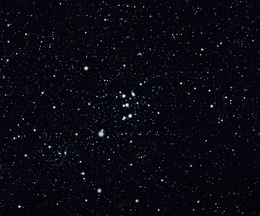CD Crucis
CD Crucis, also known as HD 311884, is an eclipsing binary star system in the constellation Crux. It is around 14,000 light years away near the faint open cluster Hogg 15. The binary contains a Wolf–Rayet star and is also known as WR 47.
| Observation data Epoch J2000 Equinox J2000 | |
|---|---|
| Constellation | Crux |
| Right ascension | 12h 43m 50.99768s[1] |
| Declination | −63° 05′ 14.8029″[1] |
| Apparent magnitude (V) | 10.81[2] (10.71 - 10.82[3]) |
| Characteristics | |
| Spectral type | WN6o + O5V[4] |
| U−B color index | −0.19[2] |
| B−V color index | +0.83[2] |
| Variable type | Eclipsing binary[3] |
| Astrometry | |
| Radial velocity (Rv) | 8.00[5] km/s |
| Proper motion (μ) | RA: −5.921±0.052[6] mas/yr Dec.: −0.409±0.047[6] mas/yr |
| Parallax (π) | 0.2336 ± 0.0382[6] mas |
| Distance | approx. 14,000 ly (approx. 4,300 pc) |
| Absolute magnitude (MV) | −6.2 (−5.2 + −5.7[7]) |
| Orbit[4][8] | |
| Primary | WR |
| Companion | O |
| Period (P) | 6.23930 days |
| Semi-major axis (a) | 0.3010" (68 R☉) |
| Eccentricity (e) | 0 |
| Inclination (i) | 67 ± 3° |
| Longitude of the node (Ω) | 3.10° |
| Semi-amplitude (K1) (primary) | 263 ± 4 km/s |
| Semi-amplitude (K2) (secondary) | 218 ± 9 km/s |
| Details | |
| WR | |
| Mass | 42.6 ± 3.6[9] M☉ |
| Radius | 5[9] R☉ |
| Luminosity | 127,000[4] L☉ |
| O | |
| Mass | 51.0 ± 2.8[9] M☉ |
| Radius | 12[9] R☉ |
| Luminosity | 880,000[4] L☉ |
| Other designations | |
| Database references | |
| SIMBAD | data |
System
CD Cru is composed of two massive and highly luminous stars aligned so that they eclipse each other as they orbit every 6 days and 6 hours. One is a hot blue O-type main sequence star of spectral type O5V that is 57 times as massive as the Sun, while the other is an even hotter Wolf–Rayet star of spectral type WN6 that is 48 times as massive as the Sun. The WR star dominates the spectrum but is less bright, so which star is considered the primary varies. For clarity the components are referred to as WR and O[4][8]
Hogg 15

Hogg 15 is a small faint open cluster that has been calculated to lie about 4.2 kpc away. CD Cru is considered a likely member of the cluster, in which case it would be the brightest member by over a magnitude. It lies outside the central two arc-minute condensation of the cluster, but well within the outer bounds discovered for the member stars. The cluster is calculated to be only eight million years old.[10]
The brighter and closer cluster NGC 4609 lies 10 arc-minutes away, and both clusters are near the centre of the dark Coalsack Nebula. Both clusters are actually more distant than the Coalsack so are seen through it rather than against it. It suffers 3.5 magnitudes of interstellar extinction.[4] Between the two clusters lies the 5th magnitude BZ Crucis, a much closer foreground object.
Properties
The WR component is five times the radius of the sun, but its high temperature means it is over 100,000 times more luminous. Its mass is determined from the orbital motion to be 42.6 M☉.
The O star is larger at 12 R☉, more luminous at 880,000 L☉, and more massive at 51 M☉. Although the stars are only separated by around 68 R☉, they are well separated because of their small size.
References
- Van Leeuwen, F. (2007). "Validation of the new Hipparcos reduction". Astronomy and Astrophysics. 474 (2): 653. arXiv:0708.1752. Bibcode:2007A&A...474..653V. doi:10.1051/0004-6361:20078357.
- Ducati, J. R. (2002). "VizieR Online Data Catalog: Catalogue of Stellar Photometry in Johnson's 11-color system". CDS/ADC Collection of Electronic Catalogues. 2237. Bibcode:2002yCat.2237....0D.
- Samus, N. N.; Durlevich, O. V.; et al. (2009). "VizieR Online Data Catalog: General Catalogue of Variable Stars (Samus+ 2007-2013)". VizieR On-line Data Catalog: B/gcvs. Originally Published in: 2009yCat....102025S. 1. Bibcode:2009yCat....102025S.
- Bhatt, H.; Pandey, J. C.; Kumar, B.; Singh, K. P.; Sagar, R. (2010). "X-ray emission characteristics of two Wolf-Rayet binaries: V444 Cyg and CD Cru". Monthly Notices of the Royal Astronomical Society. 402 (3): 1767. arXiv:0911.1489. Bibcode:2010MNRAS.402.1767B. doi:10.1111/j.1365-2966.2009.15999.x.
- Pourbaix, D.; Tokovinin, A. A.; Batten, A. H.; Fekel, F. C.; Hartkopf, W. I.; Levato, H.; Morrell, N. I.; Torres, G.; Udry, S. (2004). "SB9: The ninth catalogue of spectroscopic binary orbits". Astronomy and Astrophysics. 424 (2): 727. arXiv:astro-ph/0406573. Bibcode:2004A&A...424..727P. doi:10.1051/0004-6361:20041213.
- Brown, A. G. A.; et al. (Gaia collaboration) (August 2018). "Gaia Data Release 2: Summary of the contents and survey properties". Astronomy & Astrophysics. 616. A1. arXiv:1804.09365. Bibcode:2018A&A...616A...1G. doi:10.1051/0004-6361/201833051. Gaia DR2 record for this source at VizieR.
- Piatti, A. E.; Bica, E.; Santos, J. F. C.; Clariá, J. J. (2002). "A revision of the fundamental parameters of the open cluster Hogg 15 and the projected star WR 47" (PDF). Astronomy and Astrophysics. 387: 108. Bibcode:2002A&A...387..108P. doi:10.1051/0004-6361:20020373.
- Fahed, R.; Moffat, A. F. J. (2012). "Colliding winds in five WR+O systems of the Southern hemisphere". Monthly Notices of the Royal Astronomical Society. 424 (3): 1601. Bibcode:2012MNRAS.424.1601F. doi:10.1111/j.1365-2966.2012.20494.x.
- Moffat, Anthony F. J.; Drissen, Laurent; Robert, Carmelle; Lamontagne, Robert; Coziol, Roger; Mousseau, Normand; Niemela, Virpi S.; Cerruti, Miguel A.; Seggewiss, Wilhelm; Van Weeren, Niels (1990). "Photometric and polarimetric variability and mass-loss rate of the massive binary Wolf-Rayet star HDE 311884 (WN6 + 05: V)". Astrophysical Journal. 350: 767. Bibcode:1990ApJ...350..767M. doi:10.1086/168429.
- Moffat, A. F. J. (1974). "The Wolf-Rayet star HDE 311884 in the open cluster HOGG 15". Astronomy and Astrophysics. 34: 29. Bibcode:1974A&A....34...29M.